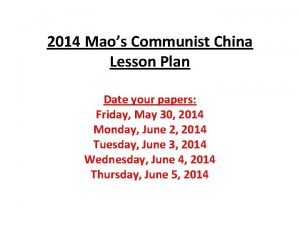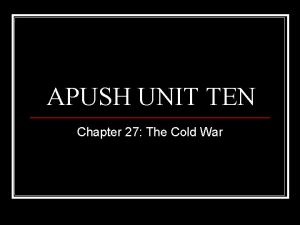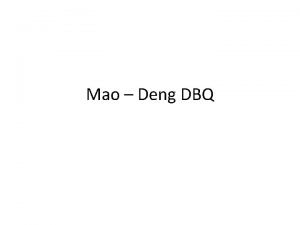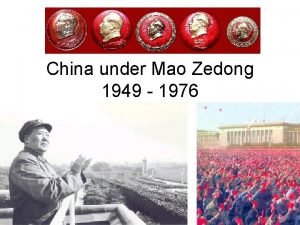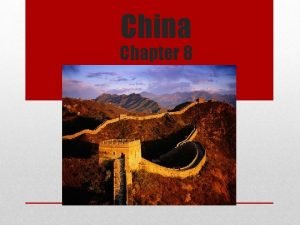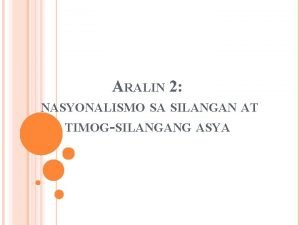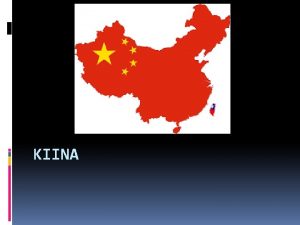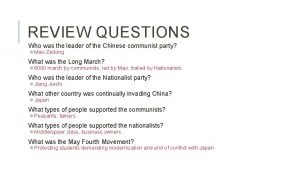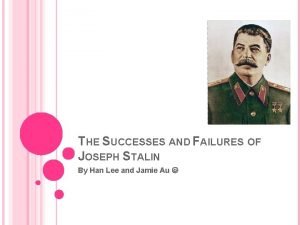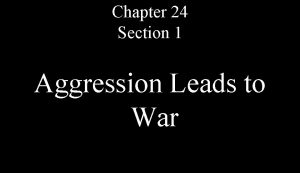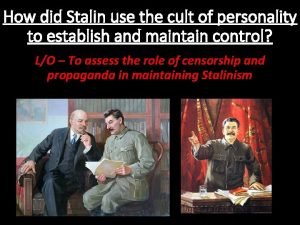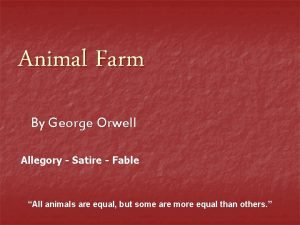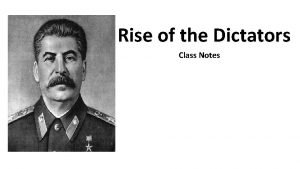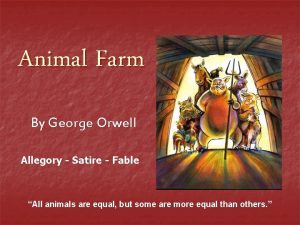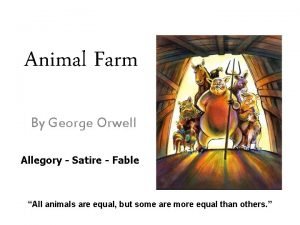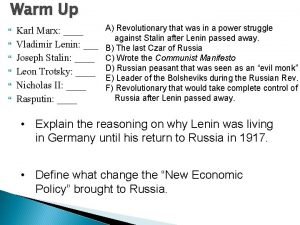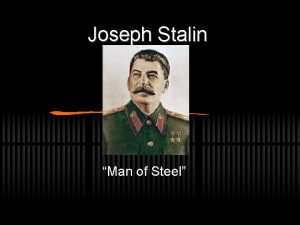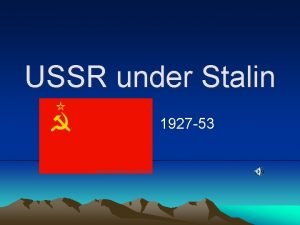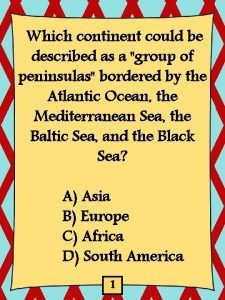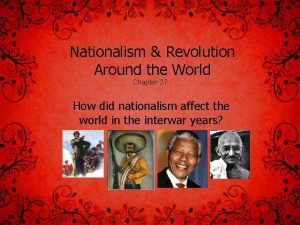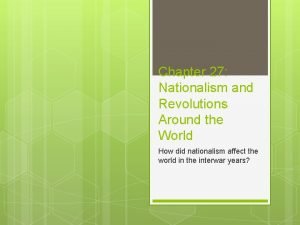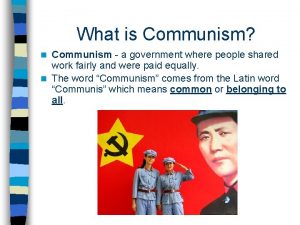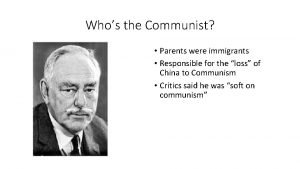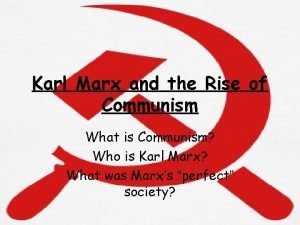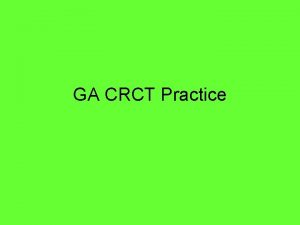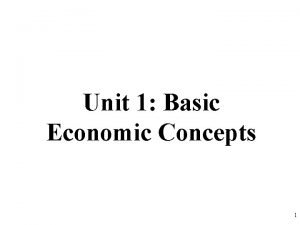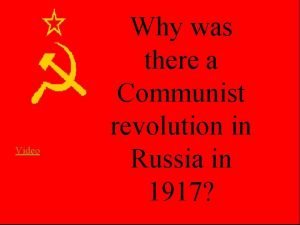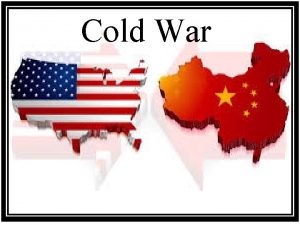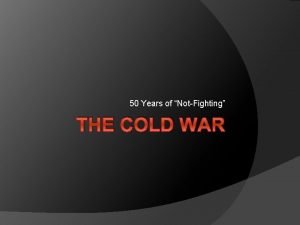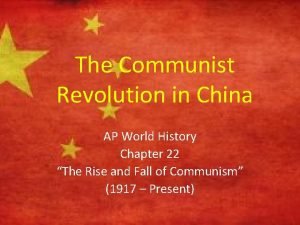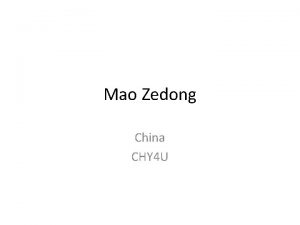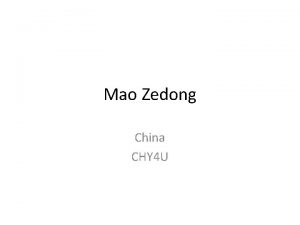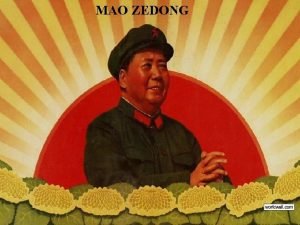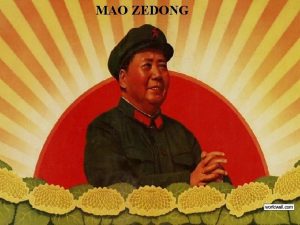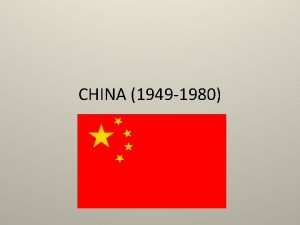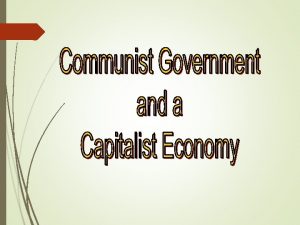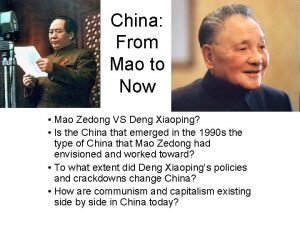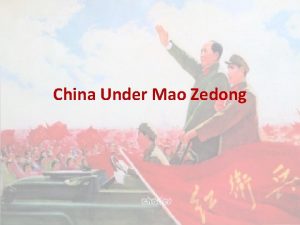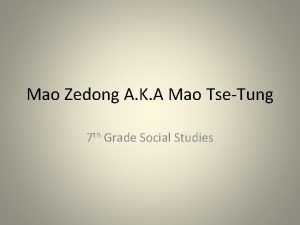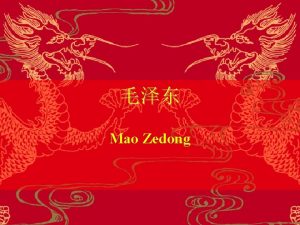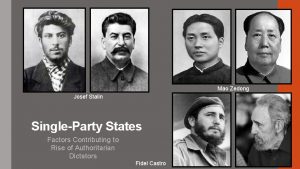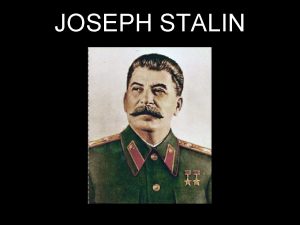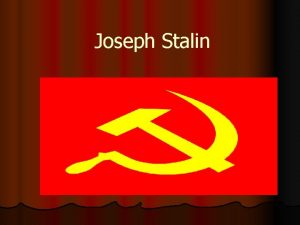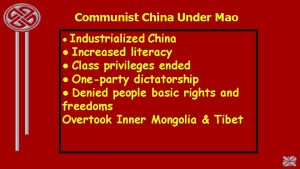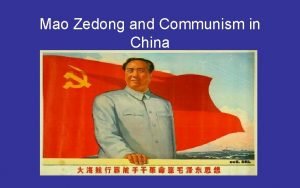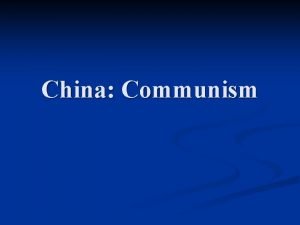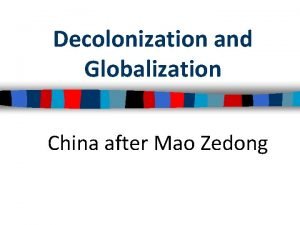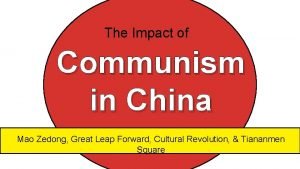Communist China Mao Zedong China Joseph Stalin Russia



































- Slides: 35

Communist China Mao Zedong - China Joseph Stalin Russia Vladimir Lenin Russia Friedrich Karl Marx Engles - Germany

When you go to China, don’t talk about the three T’s. • Tibet • Taiwan • Tiananmen Square

A Brief Overview of early Chinese History • Written history of China stretches back 4000 years • In 221 BCE, Qin Shi Huang Di unified China and established the position of emperor • 202 BCE-202 CE: Han Dynasty led China to its first Golden Age using Confucianism and Taoism • In 1271, Mongols conquered China and established a foreign ruling dynasty (Yuan dynasty) • In the 1300’s, the Ming Dynasty drove out the Mongols, reestablishing Chinese control • By 1800, China ruled 1/3 of the world’s population and is the world’s largest economy. After 1800, things begin to change in China.

Beginning in the 1830’s, China’s major cities and ports were taken over by foreign powers

In 1911, the emperor of China was overthrown and a republic was declared

With the fall of the emperor, a struggle for power began and China divided. • Tibet, which had been an independent kingdom in the 7 th century, declared its independence from China. • Established a theocratic government based on Tibetan Buddhism.

In the 1930’s, Civil War began between the Nationalists (KMT) and the Communists Mao Zedong, Leader of the Communists: Socialist and allied with Soviet Union Chiang Kai-shek, Leader of the Nationalists: Capitalist and allied with the U. S. and the U. K.

Mao Zedong • Born in 1893, influenced by the philosophy of Karl Marx • Favored land reform for the peasants and an end to foreign influence in China • Became an early member of the Chinese Communist Party in 1920 • Became military leader of the Chinese Communist Party army in 1933

How Maoist Communism differed from Soviet Communism • Soviet Communism: - focused on factory workers - based in the cities - enemies: capitalists and fascists Both Maoist and Soviet: -One party rule - Used weapons of totalitarianism -Creation of communes and use of quotas - Attempted rapid industrialization (5 Year Leap, Great Leap Forward) • Maoist Communism: - focused on peasants - based in the countryside - enemies: capitalists and imperialists

The Chinese Civil War lasted on and off from 1927 -1949. Over 8 million Chinese were killed. This resulted in 2 different states, each claiming to be the true government of China.

From 1937 -1945, China was invaded and occupied by Japan. 20 million Chinese civilians were killed. Communists and Nationalists united to fight Japan.

In 1945, with the defeat of Japan, civil war resumes in China. In 1949, the Communists take Beijing and declare the “People’s Republic of China” (PRC) as the “official government of China”.

The Nationalists fled to Taiwan and established the “Republic of China” (ROC) as the “official government of China”. Western powers saw this as the only legitimate government of China until 1971. Today, the legal and political status of Taiwan is in dispute. In 1971, the U. N. and U. S. came to acknowledge the PRC as the official government of China. Today, Taiwan sees itself as separate from mainland China. Taiwan is also a major ally of the United States of America. The PRC sees Taiwan as a part of China and refuses to have diplomatic relations with countries that view Taiwan as independent.

Communist China under Mao (1949 -1976)

• Mao is a hero! • 100 years of foreign imperialism comes to an end • Unites China for the first time in 50 years • Modernizes and industrializes China, building it into a world power • Mao is evil! • A dictator and leader of one-party rule which arrests and executes political opposition (“counterrevolutionaries”) • Attempts to industrialize lead to great suffering and starvation • During his rule, 40 -70 million die due to starvation or execution • Organizes campaigns to improve literacy and public health; empowers women • Invasion of Tibet leads to the deaths of millions and the destruction of an ancient culture • Population rises from 500 million to 900 million • Economic reforms enacted after his death were responsible for China’s rise to world power

Major Periods of Maoist China • Chinese Civil War (1927 -1949): Fought between Nationalists and Communists • Suppression of political opposition (“counterrevolutionaries”: anyone who disagreed with Mao) • Great Leap Forward (1958 -1961): Designed to modernize and industrialize the country, produced widespread famine • Cultural Revolution (1966 -1976): A program to weed out counter-revolutionary elements in Chinese society. Emphasized the new ways over the old.

Crash Course • Crash Course

Tibet

Tibet: Three Opinions • Opinion One: Tibet should be an independent country with the Dalai Lama as the leader • Opinion Two: Tibet should be an autonomous region within China which has local control and religious freedom protected • Opinion Three: Tibet threatens the unification of China and illegally challenges the authority of the Communist Party of China

TIBET

Buddhism arrived in Tibet in the 7 th century CE from India

Tibet is located in the mountains on the highest and biggest plateau in the world, averaging 14, 000 feet

This high plateau isolated Tibet and created a unique culture called Tibetan Buddhism

Tibet was first unified into a single empire in the 8 th century before being invaded by Mongols and Chinese

In 1913, Tibet gained full independence and an independent theocracy emerged with the Dalai Lama as the leader Gendu Drup was the first Dalai Lama and lived in the 15 th century

The Dalai Lama ruled Tibet from the Potala Palace in the capital of Lhasa

In 1950, the Chinese Communist Party claimed that Tibet was part of China and they moved in to occupy it in 1950 The current (14 th) Dalai Lama was born in 1935 and became ruler of Tibet in 1950.

The Chinese Communist Party disagreed with the authority of the Dalai Lama and crushed an uprising in 1959 • Over 80, 000 Tibetans were killed or imprisoned • The Dalai Lama fled to nearby India for safety • He has never returned to Tibet • In 2011, he formally gave up his temporal power in favor of spiritual authority • Today, Tibetan culture is disappearing under Chinese control

Tibet in the 21 st Century • Chinese government claims they are helping to improve life in Tibet • Every year, 3000 Tibetans flee into exile in nearby India • Chinese government encourages Han Chinese to move into Tibet to limit the Tibetan ethnic group- Dalai Lama calls it “cultural genocide” • In 2008, Tibet revolted against Chinese but the protests were crushed and all westerners were banned from Tibet for 2 years • The Communist Party refuses to meet with the Dalai Lama and refers to him as a “terrorist”

Richard Nixon visited China in 1972 to normalize relations between the U. S. and China

After Mao’s death in 1978, economic reforms were implemented and the Chinese economy began to grow

In 1989, a growing Chinese middle class demanded new political freedoms in the Tiananmen Square Protest….

But, the Chinese government said no and massacred the protesters. • Referred to by the Chinese government as the “June 4 th Incident” • Death and injury toll uncertain

Today, China has a growing market economy but a political structure which actively suppresses political freedoms

Communist China Today
 Mao zedong lesson plan
Mao zedong lesson plan Beatniks apush
Beatniks apush Mao zedong vs deng xiaoping
Mao zedong vs deng xiaoping Mao zedong outline
Mao zedong outline Sun yat sen and mao zedong
Sun yat sen and mao zedong “ama ng republikang tsino”.
“ama ng republikang tsino”. Mao zedong kuolema
Mao zedong kuolema Hitler stalin mao
Hitler stalin mao Mao mao
Mao mao Joseph stalin main accomplishments
Joseph stalin main accomplishments Japanese militarists political movement and beliefs
Japanese militarists political movement and beliefs What personality type was stalin
What personality type was stalin Joseph stalin napoleon animal farm
Joseph stalin napoleon animal farm What type of government did joseph stalin run
What type of government did joseph stalin run Who is joseph stalin in animal farm
Who is joseph stalin in animal farm Joseph stalin animal farm
Joseph stalin animal farm Karl marx vladimir lenin and joseph stalin
Karl marx vladimir lenin and joseph stalin Joseph stalin beliefs
Joseph stalin beliefs Josif stalin young
Josif stalin young Joseph stalin
Joseph stalin Stalin
Stalin Joseph stalin apush
Joseph stalin apush Which letter represents the pyrenees mountains on the map?
Which letter represents the pyrenees mountains on the map? Nationalism and revolution around the world
Nationalism and revolution around the world When did mao take over china
When did mao take over china Communist meaning
Communist meaning Communist parents
Communist parents Utopia and communism
Utopia and communism Communist manifesto penguin
Communist manifesto penguin Which statement best describes this part of the story?
Which statement best describes this part of the story? What is communism example
What is communism example Communist revolution
Communist revolution Mr. bolanos
Mr. bolanos Communist and capitalist countries cold war
Communist and capitalist countries cold war Tosconini
Tosconini Cultural revolution definition ap world history
Cultural revolution definition ap world history
